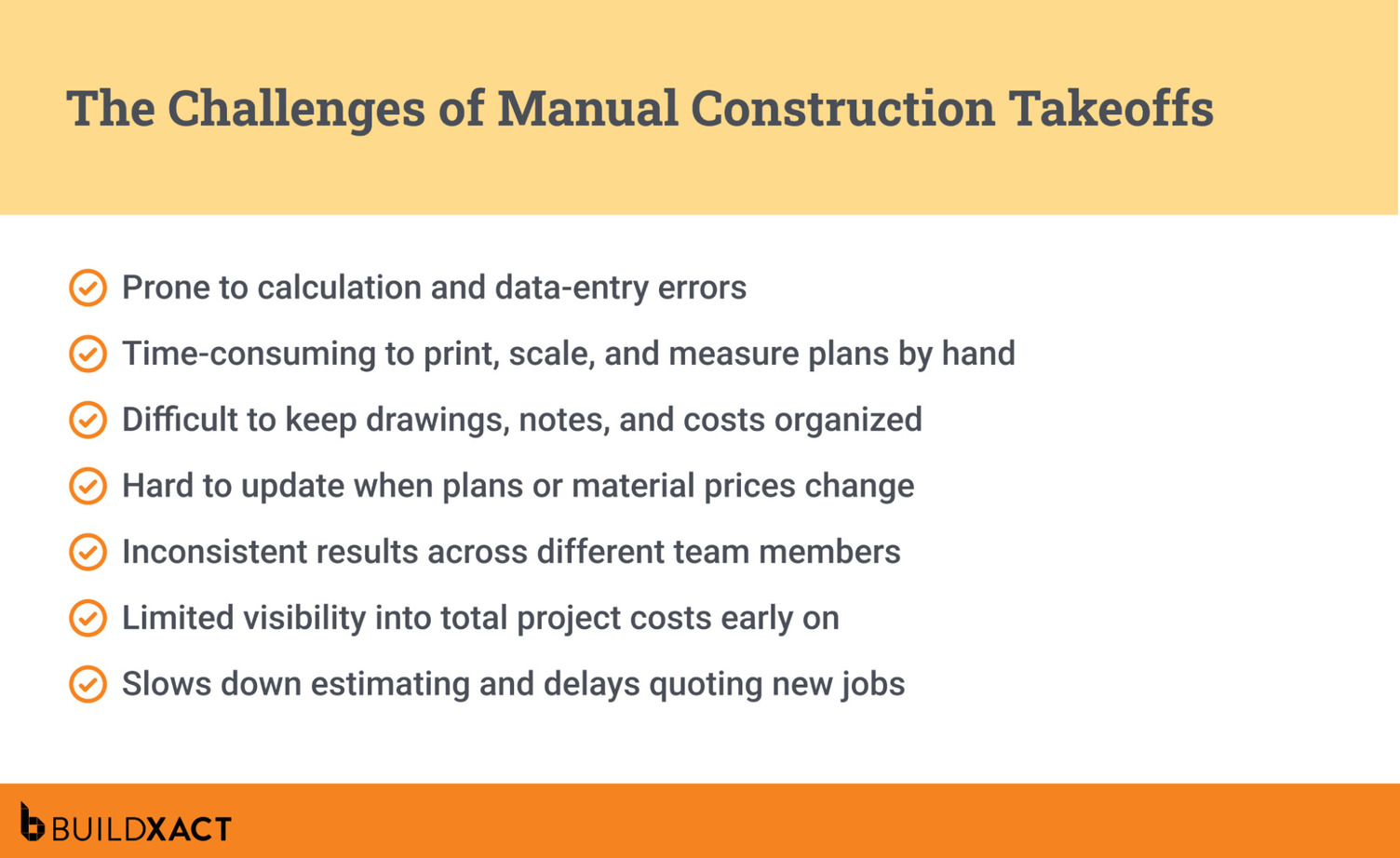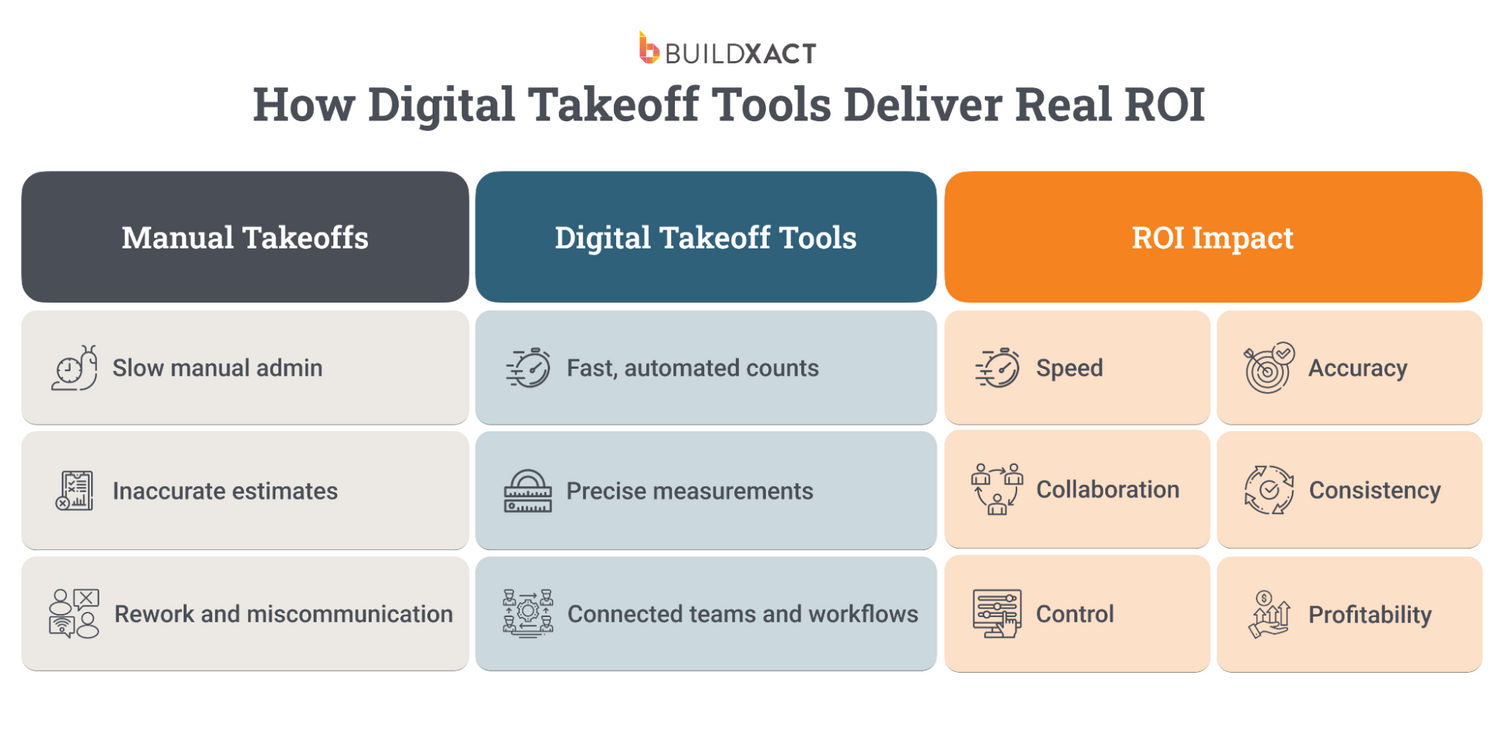When you’re quoting a job, speed and accuracy can determine whether you win the work or lose out to another bidder. Yet many small builders still rely on manual takeoffs — printing plans, measuring by hand, and updating spreadsheets line by line. Not only is this process tediously slow and prone to error, but it also leaves you vulnerable to faster competitors.
A single missed measurement or outdated cost can derail an entire bid. And when the competition is hot, clients rarely wait for a second try.
So, how can you improve your construction takeoffs to send winning bids in less time? In this guide, we’ll show you why manual takeoffs are standing in the way of successful quotes — and how the right digital takeoff tools can help you secure more of the right work.
What Does a Construction Takeoff Involve?
A takeoff is completed during the estimating process to calculate the cost to complete a project. For smaller construction businesses that don’t have a dedicated estimator, takeoffs and estimating are typically completed by the owner or builder.
Here’s what a typical takeoff process involves:
1. Review the construction drawings.
The builder reviews the plans to determine the amount of material and labor required for a successful project completion.
2. Create a material takeoff.
From framing timber to fixtures and finishes, the builder will list every material and piece of equipment needed for the job.
3. Measure quantities and dimensions.
Next, the builder will measure the areas required for walls, roofs, floors, and other structures. Traditionally, they relied on manual approaches using rulers and paper plans; now, digital tools like AI-powered takeoffs speed up the process, while keeping the details accurate (and flagging issues even experienced builders and quote professionals miss).
4. Estimate material and labor requirements.
Using the quantities from the material takeoff, the builder calculates the amount of material and labor required. Larger and more complex builds typically require a greater number of hours or more specialized tradespeople.
5. Calculate labor costs.
A detailed labor cost is developed for the project, based on estimated hours and the different trades involved.
6. Add overheads and profit.
Finally, the builder factors in administrative and operational costs, plus a markup to ensure the job is profitable. The result is the total price presented to the client.

Every profitable estimate begins with an accurate takeoff. Even small measurement mistakes or missed items can turn into budget blowouts and delays later in the build. This is why error-prone manual takeoffs can jeopardize a project’s success.
Outbid and Over Budget: The Manual Takeoff Problem
For decades, builders have relied on paper plans, rulers, and spreadsheets to complete takeoffs. Drawings must be printed at the exact right scale, and every wall, roof, and slab must be measured by hand. Materials are listed on notepads or typed into spreadsheets, while highlighters track what’s already been counted.
It’s slow, repetitive work, and every step introduces room for error. Even a single miscalculation or misplaced decimal could throw an entire estimate off balance. Understandably, manual takeoffs typically lead to a range of challenges, including:
- Prone to calculation and data-entry errors — Small mistakes in measurement or transcription can spiral into costly rework.
- Time-consuming process — Printing, scaling, and measuring by hand adds hours of admin before you can even start quoting.
- Disorganized drawings and notes — With measurements scattered across paper plans, files, and spreadsheets, it’s easy to lose track of what’s been done.
- Hard to update when plans or prices change — Every variation or material price fluctuation means reworking the entire takeoff from scratch.
- Inconsistent results between team members — Different people interpret drawings and measurements differently, making estimates unreliable.
- Limited visibility into total costs early on — Without connected data, it’s challenging to forecast margins or identify potential cost overruns.
- Slower estimating and quoting — Manual workflows delay how quickly you can bid on new jobs, letting faster competitors get in first.

As workloads grow and timelines tighten, many builders turn to shortcuts — like using square-foot rates or rough allowances — to save time. However, these quick fixes often backfire, resulting in inaccurate estimates and underquoted projects.
The builder then finds themselves in a difficult situation. Do they incur a loss on the project, or do they submit change orders to the homeowner in an attempt to recover the loss?
For small construction businesses already working on tight margins, even one inaccurate takeoff can wipe out profit and strain client relationships. Manual processes make it almost impossible to scale or stay competitive.
To keep projects profitable and quotes accurate, builders need a faster, more innovative way to complete takeoffs accurately the first time.
How Automated Takeoff Software Transforms the Takeoff Process
Today, the builders leading the pack are those using construction estimating and takeoff software to create accurate proposals quickly.
Compared to tedious manual methods, the process for creating takeoffs using automated takeoff software like Buildxact is far more straightforward:
1. Upload your plans.
Start by uploading PDF versions of your drawings directly into the software.
2. Measure and count in a few clicks.
Use digital measuring tools like Buildxact’s AI-driven measurements to calculate areas, lengths, and quantities with precision. You can also count items like doors and windows, with each area marked as completed to avoid double-counting.
3. Pull in live material costs.
Once measurements are done, features such as Buildxact’s real-time dealer integration automatically pull prices from your customized cost library. Costs stay current with easy updates from your dealers.
4. Generate and review your estimate.
The system calculates material quantities, labor, and total costs, providing you with an instant line-by-line breakdown. You can then review the data, add markup or waste, and create a professional quote in minutes.

With automated takeoff software, small projects can be estimated in minutes instead of hours, and even large project estimates take a fraction of the time. For example, builders using Buildxact’s automated AI-powered takeoff tool complete takeoffs 50% faster than manual methods, allowing them to focus more time on higher-value tasks.
“Without automation, construction managers end up spending excessive time on administrative tasks rather than focusing on strategic decision-making.”
— How to Stand Out in Your Category: Buyer Insights for Construction Software, Gartner
The measurable ROI of digital takeoff tools

The real value of digital takeoff tools goes beyond convenience. By automating manual administration, reducing rework, and enhancing estimating accuracy, these tools deliver measurable returns to small builders. Faster, more consistent takeoffs mean fewer cost overruns and more substantial margins, as well as more time to focus on the work that drives profits.
Here are some of the benefits of adopting intelligent construction takeoff software, such as Buildxact’s residential-focused platform, for builders, cost estimators, and project managers.
Accuracy that eliminates guesswork
Manual takeoffs leave room for missed items and double-counting. AI-powered tools automatically track and highlight measured areas, ensuring every item is counted once. With pinpoint accuracy built in, builders can quote with greater confidence and protect their margins from costly mistakes.
“AI tools can detect areas of cost savings, allocate resources more efficiently, and forecast future budget overruns before they arise.”
— Construction Estimating Software Market, SNS Insider
Speed that wins more work
Printing, scaling, and measuring by hand takes hours. With point-and-click measuring tools, you can complete takeoffs in minutes. Faster processes mean you can quote more projects and respond to leads faster than competitors who still rely on paper plans.
Standardized, reliable costs
Manually entering prices leads to inconsistent data and unpredictable results. By linking every material item directly to a live cost database, takeoff software standardizes pricing across your team and keeps everyone working from the same up-to-date information.
Integrated workflows, zero rework
Disconnected systems create delays and errors. Integrated takeoff, estimating, and project management tools enable seamless transition from measurement to estimate to bid. Features like automatic data transfer between stages avoid double-handling and project disruptions.
Collaboration that keeps everyone aligned
When estimates and project documents are shared via email or stored in separate files, updates are often missed, and communication breaks down. Takeoff software makes it easy to share plans and cost data in one place, keeping builders, subcontractors, and clients aligned at every stage.

Professional, polished bids
Messy spreadsheets and inconsistent proposals make you look unprepared. With construction takeoff software like Buildxact, you can create branded, professional quotes that clearly show clients what they’re paying for. You’ll stand out, win more work, and strengthen your credibility.
Everything in one place
Paper notes and scattered spreadsheets cause version chaos, making it virtually impossible to stay organized. With intelligent takeoff software, all drawings, blueprints, measurements, and costs live in one connected platform. You’ll have full visibility into project quantities and budgets, with no surprises during the build.
Data that drives smarter decisions
Without connected data, predicting job costs or tracking cash flow is as good as gambling. Digital takeoff tools centralize quantities, labor, and live material pricing, giving builders a real-time view of costs and profit margins. That visibility helps prevent overruns and supports better financial decisions
Tools designed to boost profits
Manual errors and slow bidding processes eat into profit. With digital takeoff software, you can generate accurate bids that win more jobs while avoiding costly rework.
Plus, affordable subscription costs (such as Buildxact’s unlimited user pricing) deliver faster ROI. For example, the Buildxact Pro annual subscription pays for itself in just one completed job, with an average 12.8x ROI on their Buildxact investment.
Pro-tip: If you’re wondering how to identify the best takeoff platform for your business, check out our review of some of the top takeoff tools on the market in our guide to the best takeoff software options for residential builders.
Takeoffs in Construction: FAQs
How to do a construction takeoff?
Begin by reviewing the project drawings to understand the scope of work. Measure and record quantities for materials, fixtures, and labor needed to complete the build. Then apply accurate unit prices and labor rates to each item to calculate total costs and prepare a detailed, itemized estimate. Digital takeoff software automates these steps, enabling you to create accurate takeoffs more efficiently.
What’s the difference between an estimate and a takeoff?
A takeoff measures and quantifies all materials and labor needed for a job. An estimate builds on that data by applying current material prices, labor rates, overhead, and profit margins to calculate the total project cost presented to the client.
How to improve accuracy in construction takeoffs?
Use digital takeoff software with point-and-click measurement, automatic error checking, and live supplier pricing. These tools eliminate manual data entry, ensure consistent quantities, and keep pricing up to date, helping to build precise and profitable estimates.
Send Accurate Takeoffs Faster and Win More of the Right Work
Every winning bid starts with a precise takeoff. When your measurements, costs, and quantities are right from the start, your estimates stay consistent and your quotes stay competitive.
As we’ve seen, the builders who move beyond manual methods are gaining a real advantage. Equipped with the right digital tools, you can complete takeoffs faster and price jobs with pinpoint precision.
Buildxact’s AI-powered takeoff tools let you do exactly that, giving small home builders the competitive edge they need to stand out and win more jobs. Ready to get started? Sign up for a 14-day free trial or book a demo today.














